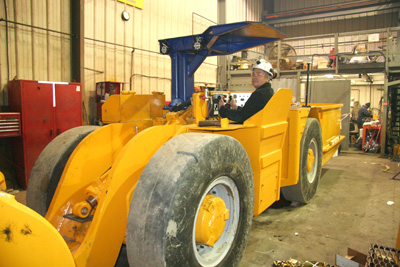 The rising cost of ventilation and stricter emission standards for diesel engines have persuaded RDH Mining Equipment to introduce a fully electric line of underground equipment beginning witha three-yard load-haul-dump (LHD) machine.
The rising cost of ventilation and stricter emission standards for diesel engines have persuaded RDH Mining Equipment to introduce a fully electric line of underground equipment beginning witha three-yard load-haul-dump (LHD) machine.
“Pretty soon, all new equipment will have to be built to Tier 4 standards,” said RDH president Rick Lemieux. “For the engine compartment you’re going to almost need a trailer behind to bring the exhaust and filtration systems because they will be so huge and costly. Plus, you’ll still need ventilation. By going fully electric, we’re ahead of the game.”The company, based in Alban, 50 kilometres south of Sudbury, has already sold four of the machines to Kirkland Lake Gold.“Older mines with a lack of CFM can buy our equipment and live with what they have, said Lemieux.
Mines that have maxed out their ventilation capacity face the risk of having to curtail production.
“You have to realize that every CFM you bring underground in the winter up north, you have to heat with propane. It’s a very costly thing.”
The electric LHD is battery powered and can be plugged in at lunchtime and during coffee breaks. A fully charged battery is good for four or five hours. The targeted rapid charge time is between one to 2.5 hours.
According to Lemieux, RDH’s battery poweredLHDs are a first for underground hard rock mining. Some companies in the U.S. manufacture battery-powered LHDs for the coal mining industry, but “they’re just rolling machines. Ours have to do the same thing as a regular diesel scoop. They have to spin their tires and get into the muckpile whether they’re going uphill or downhill, and they have to load a truck.”
Plans for a battery-powered 20-tonne truck and a 1.5-yard LHD are on the drawing board.
RDH is also introducing a new line of low profile equipment beginning with a 22-man carrier for a customer in Africa. Ideal for platinum mines following seams, low profile equipment can be operated in drifts with reduced height, limiting waste, wear and tear on the crusher and the use of explosives. The carrier boasts a 5-foot high canopy and a 4.5-foot high back end, said Lemieux.
The company has orders for several low profile machines, including a one-boom jumbo, a 12-tonne truck and an anfo loader with a 450-pound tank.
The low-profile one-boom jumbo isn’t new to the market, but the RDH design offers three feet more lateral coverage because the boom is on a table that moves 1.5 feet to the right and 1.5 feet to the left, said Lemieux.
The low profile designs and RDH’s recent success in obtaining MSHA explosion-proof certification for its trucks, jumbos, bolters and scissor lifts open the door to the huge U.S. coal mining market.
According to Lemieux, the company currently has 62 people on the payroll, but accounts for approximately 250 jobs in northeastern Ontario through subcontracts for frames, drivelines and other components farmed out to mining suppliers between Elliot Lake and North Bay.
The company’s success in the North American marketplace and in export markets as diverse as Africa and Latin America is based on two principles, said Lemieux. “Never burn a bridge is number one. Number two is customer service is more important than selling a machine. Nobody talks about when you did a good job because that’s what you’re supposed to do, but you do one bad job and everybody knows.”

